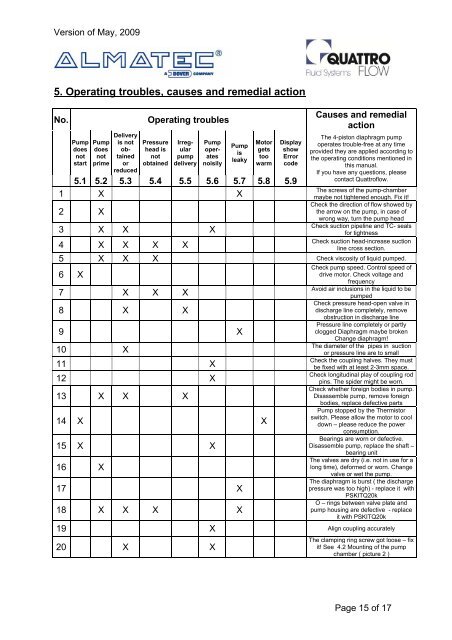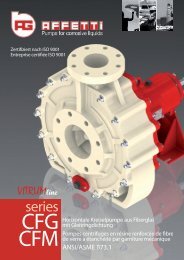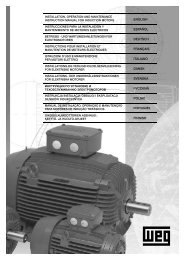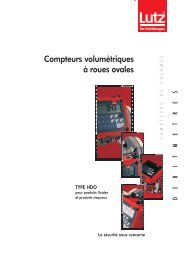User Manual Quattroflow-20k Series 4-Piston Diaphragm Pump
User Manual Quattroflow-20k Series 4-Piston Diaphragm Pump
User Manual Quattroflow-20k Series 4-Piston Diaphragm Pump
You also want an ePaper? Increase the reach of your titles
YUMPU automatically turns print PDFs into web optimized ePapers that Google loves.
Version of May, 2009<br />
5. Operating troubles, causes and remedial action<br />
No. Operating troubles<br />
<strong>Pump</strong><br />
does<br />
not<br />
start<br />
<strong>Pump</strong><br />
does<br />
not<br />
prime<br />
Delivery<br />
is not<br />
obtained<br />
or<br />
reduced<br />
Pressure<br />
head is<br />
not<br />
obtained<br />
Irregular<br />
pump<br />
delivery<br />
<strong>Pump</strong><br />
operates<br />
noisily<br />
<strong>Pump</strong><br />
is<br />
leaky<br />
Motor<br />
gets<br />
too<br />
warm<br />
Display<br />
show<br />
Error<br />
code<br />
5.1 5.2 5.3 5.4 5.5 5.6 5.7 5.8 5.9<br />
1 X X<br />
2 X<br />
3 X X X<br />
4 X X X X<br />
Causes and remedial<br />
action<br />
The 4-piston diaphragm pump<br />
operates trouble-free at any time<br />
provided they are applied according to<br />
the operating conditions mentioned in<br />
this manual.<br />
If you have any questions, please<br />
contact <strong>Quattroflow</strong>.<br />
The screws of the pump-chamber<br />
maybe not tightened enough. Fix it!<br />
Check the direction of flow showed by<br />
the arrow on the pump, in case of<br />
wrong way, turn the pump head<br />
Check suction pipeline and TC- seals<br />
for tightness<br />
Check suction head-increase suction<br />
line cross section.<br />
5 X X X Check viscosity of liquid pumped.<br />
6 X<br />
7 X X X<br />
8 X X<br />
9 X<br />
10 X<br />
11 X<br />
12 X<br />
13 X X X<br />
14 X X<br />
15 X X<br />
16 X<br />
17 X<br />
18 X X X X<br />
Check pump speed. Control speed of<br />
drive motor. Check voltage and<br />
frequency<br />
Avoid air inclusions in the liquid to be<br />
pumped<br />
Check pressure head-open valve in<br />
discharge line completely, remove<br />
obstruction in discharge line<br />
Pressure line completely or partly<br />
clogged <strong>Diaphragm</strong> maybe broken<br />
Change diaphragm!<br />
The diameter of the pipes in suction<br />
or pressure line are to small<br />
Check the coupling halves. They must<br />
be fixed with at least 2-3mm space.<br />
Check longitudinal play of coupling rod<br />
pins. The spider might be worn.<br />
Check whether foreign bodies in pump.<br />
Disassemble pump, remove foreign<br />
bodies, replace defective parts<br />
<strong>Pump</strong> stopped by the Thermistor<br />
switch. Please allow the motor to cool<br />
down – please reduce the power<br />
consumption.<br />
Bearings are worn or defective.<br />
Disassemble pump, replace the shaft –<br />
bearing unit<br />
The valves are dry (i.e. not in use for a<br />
long time), deformed or worn. Change<br />
valve or wet the pump.<br />
The diaphragm is burst ( the discharge<br />
pressure was too high) - replace it with<br />
PSKITQ<strong>20k</strong><br />
O – rings between valve plate and<br />
pump housing are defective - replace<br />
it with PSKITQ<strong>20k</strong><br />
19 X Align coupling accurately<br />
20 X X<br />
The clamping ring screw got loose – fix<br />
it! See 4.2 Mounting of the pump<br />
chamber ( picture 2 )<br />
Page 15 of 17





